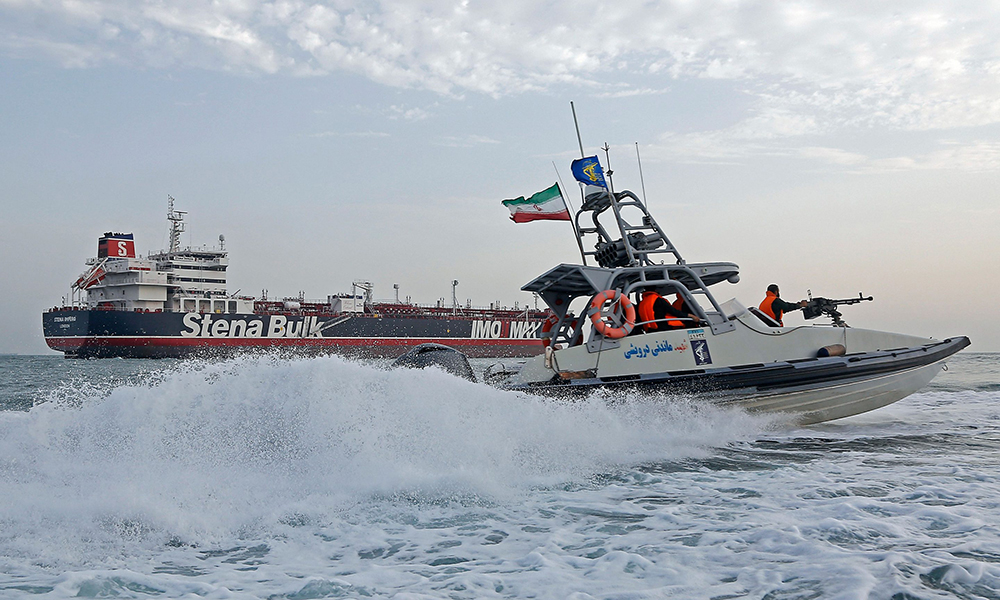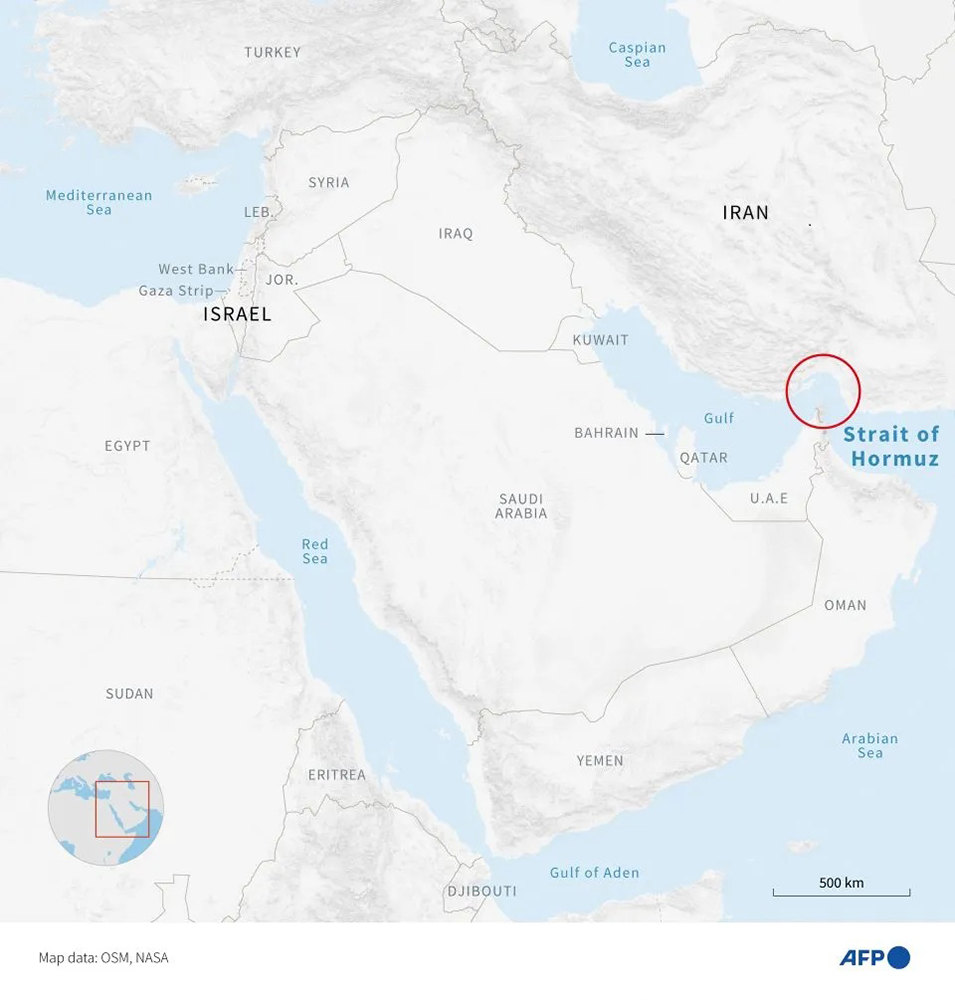
隨著以伊雙方停火,,這場(chǎng)持續(xù)12天的戰(zhàn)爭(zhēng)暫時(shí)告一段落,。美國(guó)總統(tǒng)特朗普6月24日稱(chēng),以色列和伊朗的?;饏f(xié)議已生效,。以色列宣布接受停火,,伊朗方面宣布取得勝利,。
霍爾木茲海峽作為全球能源貿(mào)易的關(guān)鍵咽喉要道,安全風(fēng)險(xiǎn)仍然困擾著船東和來(lái)往船只,。周一該水道仍保持暢通,,不過(guò)部分油輪已選擇繞行該海峽。
根據(jù)美國(guó)能源信息署(EIA)的數(shù)據(jù),,平均每天有2000萬(wàn)桶石油經(jīng)由該海峽運(yùn)輸,,約占全球石油液體消費(fèi)量的20%和全球海運(yùn)石油貿(mào)易總量的四分之一。
美國(guó)能源信息署稱(chēng),,除石油外,,去年全球約五分之一的液化天然氣貿(mào)易也經(jīng)霍爾木茲海峽運(yùn)輸,這些液化天然氣主要來(lái)自卡塔爾,。
鑒于霍爾木茲海峽對(duì)能源貿(mào)易的重要性,,若其遭遇封鎖,將引發(fā)市場(chǎng)劇烈動(dòng)蕩,。德意志銀行外匯研究主管喬治·薩拉維洛斯(George Saravelos)本月早些時(shí)候在一份報(bào)告中估計(jì),,在最糟糕的情形下——伊朗石油供應(yīng)完全中斷且霍爾木茲海峽被封鎖——油價(jià)或升至每桶120美元以上,較當(dāng)前布倫特原油價(jià)格高出56%,。
任何封鎖行動(dòng)都可能涉及動(dòng)用水雷,、巡邏艇、飛機(jī),、巡航導(dǎo)彈和柴油潛艇,。盡管美國(guó)海軍已在該地區(qū)部署實(shí)力強(qiáng)勁的艦隊(duì),但清除海峽障礙可能需要數(shù)周甚至數(shù)月時(shí)間,。

但存在替代路線(xiàn)可幫助緩解封鎖帶來(lái)的部分影響,。
例如,,根據(jù)美國(guó)能源信息署的數(shù)據(jù),沙特阿拉伯國(guó)家石油公司(Saudi Aramco)運(yùn)營(yíng)的一條原油管道從波斯灣附近的阿布蓋格石油加工中心向東西方向延伸,,最終連通至紅海沿岸的延布港,。
阿拉伯聯(lián)合酋長(zhǎng)國(guó)還運(yùn)營(yíng)著另一條管道,該管道繞過(guò)霍爾木茲海峽,,將陸上油田與位于阿曼灣的富查伊拉出口終端連接起來(lái),。
美國(guó)能源信息署估計(jì),沙特和阿聯(lián)酋的輸油管道每天可將260萬(wàn)桶石油從霍爾木茲海峽分流出去,。
相比之下,,沙特去年經(jīng)該海峽出口的原油和凝析油達(dá)每天550萬(wàn)桶。
伊朗在阿曼灣擁有一條輸油管道及一個(gè)出口終端,,借此可繞過(guò)霍爾木茲海峽,。該管道日輸送能力約為30萬(wàn)桶,然而實(shí)際使用量卻遠(yuǎn)低于這一水平,。據(jù)美國(guó)能源信息署數(shù)據(jù)顯示,,2024年夏季,伊朗經(jīng)此替代路線(xiàn)的日出口量不足7萬(wàn)桶,,且自2024年9月起便已停止裝貨,。
相比之下,伊朗去年平均每天約150萬(wàn)桶的石油出口量中,,絕大多數(shù)都是經(jīng)由霍爾木茲海峽運(yùn)輸,。
許多分析師認(rèn)為伊朗封鎖海峽的可能性較低,因?yàn)榇伺e將嚴(yán)重?fù)p害本國(guó)經(jīng)濟(jì),,并可能引發(fā)美國(guó)采取災(zāi)難性報(bào)復(fù)行動(dòng),。
本月早些時(shí)候,前中情局波斯灣軍事分析師,、前國(guó)家安全委員會(huì)波斯灣事務(wù)主任肯尼斯·波拉克(Kenneth Pollack)在《外交事務(wù)》雜志的專(zhuān)欄文章中指出,,伊朗封鎖霍爾木茲海峽的可能性極低。
他預(yù)測(cè),,伊朗將迅速?gòu)摹按蠖鄶?shù)國(guó)家眼中的同情對(duì)象轉(zhuǎn)變?yōu)槲kU(xiǎn)的敵對(duì)方”,,西方國(guó)家將動(dòng)用武力重新開(kāi)放該海峽。
波拉克補(bǔ)充道:“伊朗還需擔(dān)心,,此類(lèi)對(duì)全球經(jīng)濟(jì)構(gòu)成威脅的魯莽行為,,將使華盛頓認(rèn)定伊朗政權(quán)必須被推翻。這種擔(dān)憂(yōu)在唐納德·特朗普[(他于2020年1月下令擊殺伊朗將軍卡西姆·蘇萊曼尼(Qassem Soleimani)]重新執(zhí)政后無(wú)疑更為強(qiáng)烈,?!保ㄘ?cái)富中文網(wǎng))
譯者:中慧言-王芳
隨著以伊雙方停火,,這場(chǎng)持續(xù)12天的戰(zhàn)爭(zhēng)暫時(shí)告一段落,。美國(guó)總統(tǒng)特朗普6月24日稱(chēng),,以色列和伊朗的停火協(xié)議已生效,。以色列宣布接受?;穑晾史矫嫘既〉脛倮?。
霍爾木茲海峽作為全球能源貿(mào)易的關(guān)鍵咽喉要道,安全風(fēng)險(xiǎn)仍然困擾著船東和來(lái)往船只,。周一該水道仍保持暢通,,不過(guò)部分油輪已選擇繞行該海峽。
根據(jù)美國(guó)能源信息署(EIA)的數(shù)據(jù),,平均每天有2000萬(wàn)桶石油經(jīng)由該海峽運(yùn)輸,,約占全球石油液體消費(fèi)量的20%和全球海運(yùn)石油貿(mào)易總量的四分之一。
美國(guó)能源信息署稱(chēng),,除石油外,,去年全球約五分之一的液化天然氣貿(mào)易也經(jīng)霍爾木茲海峽運(yùn)輸,這些液化天然氣主要來(lái)自卡塔爾,。
鑒于霍爾木茲海峽對(duì)能源貿(mào)易的重要性,,若其遭遇封鎖,將引發(fā)市場(chǎng)劇烈動(dòng)蕩,。德意志銀行外匯研究主管喬治·薩拉維洛斯(George Saravelos)本月早些時(shí)候在一份報(bào)告中估計(jì),,在最糟糕的情形下——伊朗石油供應(yīng)完全中斷且霍爾木茲海峽被封鎖——油價(jià)或升至每桶120美元以上,較當(dāng)前布倫特原油價(jià)格高出56%,。
任何封鎖行動(dòng)都可能涉及動(dòng)用水雷,、巡邏艇、飛機(jī),、巡航導(dǎo)彈和柴油潛艇,。盡管美國(guó)海軍已在該地區(qū)部署實(shí)力強(qiáng)勁的艦隊(duì),但清除海峽障礙可能需要數(shù)周甚至數(shù)月時(shí)間,。
但存在替代路線(xiàn)可幫助緩解封鎖帶來(lái)的部分影響,。
例如,根據(jù)美國(guó)能源信息署的數(shù)據(jù),,沙特阿拉伯國(guó)家石油公司(Saudi Aramco)運(yùn)營(yíng)的一條原油管道從波斯灣附近的阿布蓋格石油加工中心向東西方向延伸,,最終連通至紅海沿岸的延布港。
阿拉伯聯(lián)合酋長(zhǎng)國(guó)還運(yùn)營(yíng)著另一條管道,,該管道繞過(guò)霍爾木茲海峽,,將陸上油田與位于阿曼灣的富查伊拉出口終端連接起來(lái)。
美國(guó)能源信息署估計(jì),,沙特和阿聯(lián)酋的輸油管道每天可將260萬(wàn)桶石油從霍爾木茲海峽分流出去,。
相比之下,,沙特去年經(jīng)該海峽出口的原油和凝析油達(dá)每天550萬(wàn)桶。
伊朗在阿曼灣擁有一條輸油管道及一個(gè)出口終端,,借此可繞過(guò)霍爾木茲海峽,。該管道日輸送能力約為30萬(wàn)桶,然而實(shí)際使用量卻遠(yuǎn)低于這一水平,。據(jù)美國(guó)能源信息署數(shù)據(jù)顯示,,2024年夏季,伊朗經(jīng)此替代路線(xiàn)的日出口量不足7萬(wàn)桶,,且自2024年9月起便已停止裝貨,。
相比之下,伊朗去年平均每天約150萬(wàn)桶的石油出口量中,,絕大多數(shù)都是經(jīng)由霍爾木茲海峽運(yùn)輸,。
許多分析師認(rèn)為伊朗封鎖海峽的可能性較低,因?yàn)榇伺e將嚴(yán)重?fù)p害本國(guó)經(jīng)濟(jì),,并可能引發(fā)美國(guó)采取災(zāi)難性報(bào)復(fù)行動(dòng),。
本月早些時(shí)候,前中情局波斯灣軍事分析師,、前國(guó)家安全委員會(huì)波斯灣事務(wù)主任肯尼斯·波拉克(Kenneth Pollack)在《外交事務(wù)》雜志的專(zhuān)欄文章中指出,,伊朗封鎖霍爾木茲海峽的可能性極低。
他預(yù)測(cè),,伊朗將迅速?gòu)摹按蠖鄶?shù)國(guó)家眼中的同情對(duì)象轉(zhuǎn)變?yōu)槲kU(xiǎn)的敵對(duì)方”,,西方國(guó)家將動(dòng)用武力重新開(kāi)放該海峽。
波拉克補(bǔ)充道:“伊朗還需擔(dān)心,,此類(lèi)對(duì)全球經(jīng)濟(jì)構(gòu)成威脅的魯莽行為,,將使華盛頓認(rèn)定伊朗政權(quán)必須被推翻。這種擔(dān)憂(yōu)在唐納德·特朗普[(他于2020年1月下令擊殺伊朗將軍卡西姆·蘇萊曼尼(Qassem Soleimani)]重新執(zhí)政后無(wú)疑更為強(qiáng)烈,?!保ㄘ?cái)富中文網(wǎng))
譯者:中慧言-王芳
The Strait of Hormuz avoided Tehran’s initial response to the U.S. bombing of Iran’s nuclear facilities over the weekend, sending oil prices lower.
Still, the Strait of Hormuz is a critical choke point in the global energy trade that could be blocked by Iran. Iranian lawmakers approved its closure after the U.S. attack, but security officials have yet to sign off on it, and the waterway remained open on Monday. Some tankers are steering away from the strait anyway.
According to the U.S. Energy Information Administration (EIA), an average of 20 million barrels of oil a day flow through the strait, or the equivalent of about 20% of global petroleum liquids consumption and about one-quarter of total global seaborne oil trade.
In addition to oil, about one-fifth of global liquefied natural gas trade also passed through the Strait of Hormuz last year, primarily from Qatar, EIA says.
Given its importance to the energy trade, the strait’s closure would cause massive turmoil in markets. In a note earlier this month, George Saravelos, head of FX research at Deutsche Bank, estimated that the worst-case scenario—a complete disruption to Iranian oil supplies and a closure of the Strait of Hormuz—could send oil prices above $120 per barrel. That would represent a 56% increase over the current price of Brent crude.
Any closure might entail use of mines, patrol boats, aircraft, cruise missiles, and diesel submarines. While the U.S. Navy has deployed a formidable array of ships to the region, clearing the strait could take weeks or months.
But there are alternative routes that could help mitigate some of the effects of any closure.
For example, state-run energy giant Saudi Aramco operates a crude oil pipeline that runs east and west from the Abqaiq oil processing center near the Persian Gulf to the port of Yanbu on the Red Sea, according to EIA.
The United Arab Emirates operates another pipeline that bypasses the Strait of Hormuz by linking onshore oilfields to the Fujairah export terminal in the Gulf of Oman.
EIA estimates that the Saudi and UAE pipelines could be used to divert 2.6 million barrels per day from the Strait of Hormuz.
That compares with 5.5 million barrels per day of crude and condensate that Saudi Arabia exported through the strait last year.
Iran also has a pipeline and export terminal on the Gulf of Oman that could bypass the Strait of Hormuz. The pipeline’s capacity is about 300,000 barrels per day, but its actual use has been far less than that. During the summer of 2024, Iran exported fewer than 70,000 barrels per day through that alternate route and stopped loading cargoes after September 2024, according to the EIA.
By contrast, the vast majority of Iran’s oil exports, which averaged about 1.5 million barrels per day last year, go through the Strait of Hormuz.
Many analysts see an Iranian closure of the strait as unlikely since doing so would devastate its own economy in the process and trigger a potentially catastrophic response from the U.S.
In a column in Foreign Affairs magazine earlier this month, Kenneth Pollack, a former CIA Persian Gulf military analyst and former director for Persian Gulf affairs at the National Security Council, said there’s a low probability Iran would close the strait.
That’s because Iran would quickly go from a “sympathetic victim to a dangerous nemesis in the eyes of most other countries,” while Western countries would use force to reopen the strait, he predicted.
“And Tehran would have to worry that such a reckless threat to the world’s economies would convince Washington that the Iranian regime had to be removed,” Pollack added. “That fear is surely greater with U.S. President Donald Trump—who ordered the death of Iranian general Qassem Soleimani in January 2020—back in office.”






